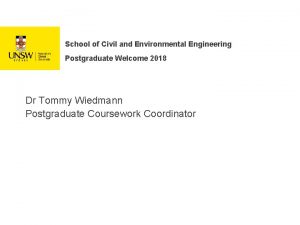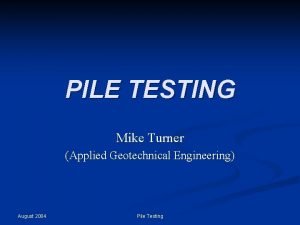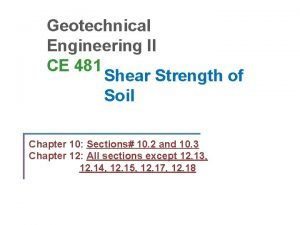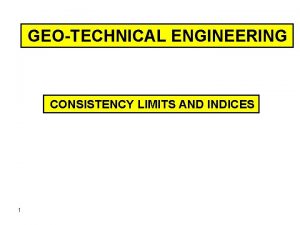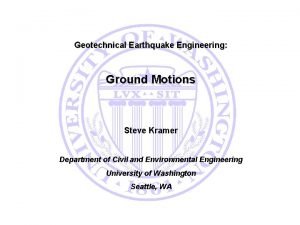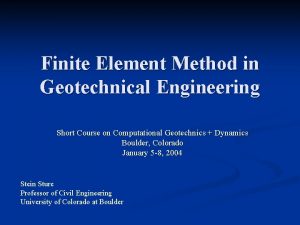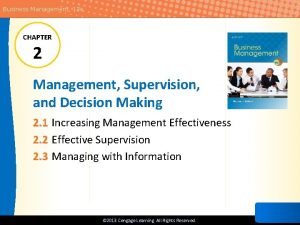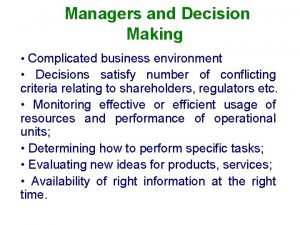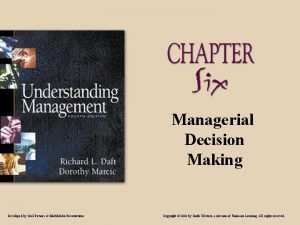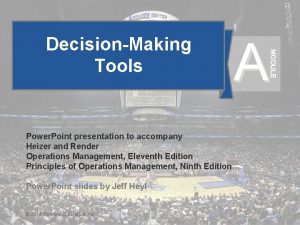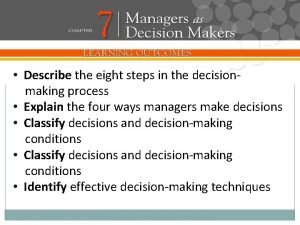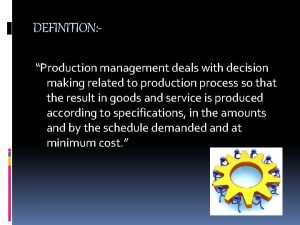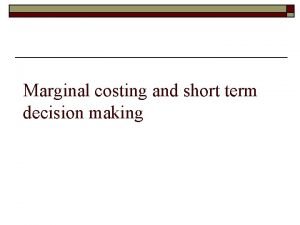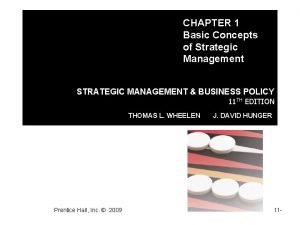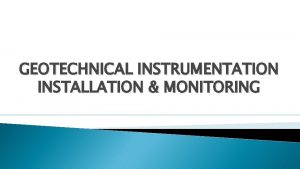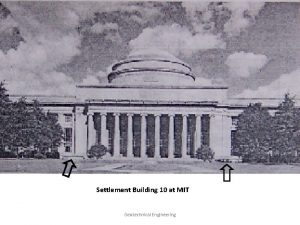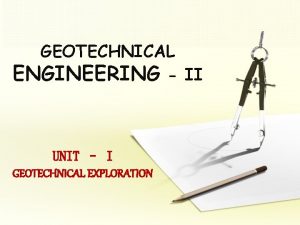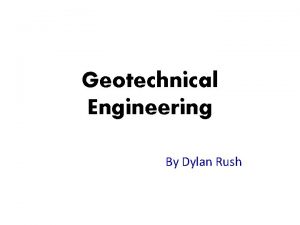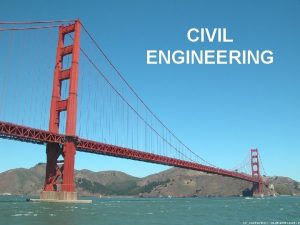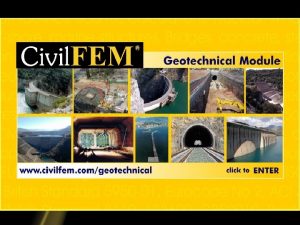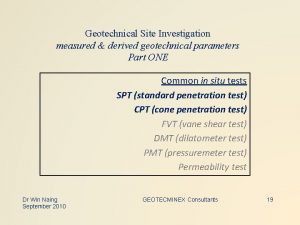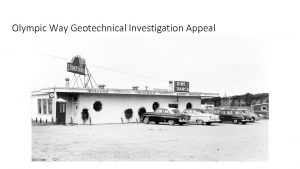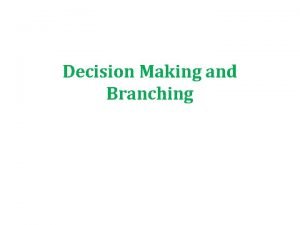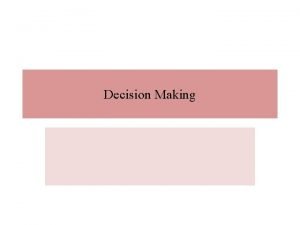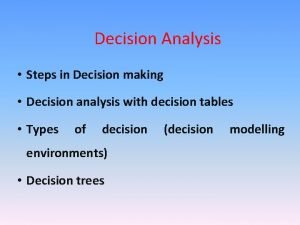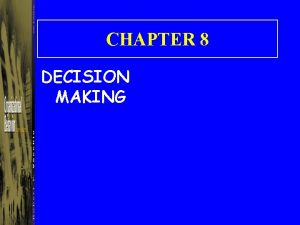Decision Making and Data Management in Geotechnical Engineering



























- Slides: 27

Decision Making and Data Management in Geotechnical Engineering Silas Nichols Principal Bridge Engineer – Geotechnical Federal Highway Administration Office of Bridges and Structures

Influencing Trends and Opportunities • Better Informed Decision Making in Project Delivery • Effective Management and Communication of Geotechnical Data

Log-In Screen 3

Deep Mixing Methods

Aggregate Columns Light Weight Fill

Column Supported Embankments

Technologies Included • • Aggregate Columns Beneficial Reuse of Waste Materials Bio-Treatment for Subgrade Stabilization Blast Densification Bulk-Infill Grouting Chemical Grouting/ Injection Systems Chemical Stabilization of Subgrades & Bases • • Column-Supported Embankments Combined Soil Stabilization with Vertical Columns Compaction Grouting Continuous Flight Auger Piles Deep Dynamic Compaction Deep Mixing Methods Shallow Mass Mixing

Technologies Included (cont. ) • • • Intelligent Compaction Jet Grouting Light Weight Fills Mechanical Stabilization of Subgrades & Bases MSE Walls Micro-Piles Onsite Use of Recycled Pavement Materials Partial Encapsulation PVDs & Fill Preloading • • • Rapid Impact Compaction Reinforced Soil Slopes Sand Compaction Piles Screw-In Soil Nailing Shoot-In Soil Nailing Shored MSE Walls Traditional Compaction Vacuum Preloading w/ & w/o PVDs Vibrocompaction Vibro-Concrete Columns

• • Technologies Included (cont. ) Drilled/Grouted & Hollow Bar Soil Nailing Electro-Osmosis Excavation & Replacement Fiber Reinforcement in Pavement Systems Geocell Confinement in Pavement Systems Geosynthetic Reinforced Construction Platforms Geosynthetic Reinforced Embankments • • Geosynthetic Reinforce-ment in Pavement Systems Geosynthetic Separation in Pavement Systems Geosynthetics in Pavement Drainage Geotextile Encased Columns High-Energy Impact Rollers Hydraulic Fill + Vacuum Consolidation + PVDs Injected Lightweight Foam Fill

www. Geo. Tech. Tools. org Case Histories Technology Fact Sheets Photographs Design Procedures QC/QA Procedures Cost Estimating Tools Specifications >50 Technologies Technical Bibliography

Research & Vetting Process 38 Post-Doc & Grad Students 1, 000 s pages Tech Docs Research & Develop 38 Post-Doc & Grad Students & 12 Principal Investigators & Advisory Board & Peer Reviewers 100 s page Summaries 8 Tools – 2 to 40 pages each

Value Added The system collects, synthesizes, integrates, and organizes a vast amount of critically important information about geotechnical solutions on a readily accessible website

Did you know… …That up to half of all construction claims in highway works are related to geotechnical issues. www. Geo. Tech. Tools. org

Application Areas Construction over Unstable Soils Geotechnical Pavement Components (Base, Subbase, and Subgrade) Construction over Stable/Stabilized Soils Working Platforms

Project Management Example Guide Illustration: Manage Change Initiate and Align Plan the Work Endorse the Plan Work the Plan Transitio n and Closure After: http: //www. wsdot. wa. gov/Projects/Project. Mgmt/PMOG. htm

Constraints and Risks Examples • Constraint: 3 -inch Settlement Limit • Risk: Settlement exceeds 3 inches • Constraint: 90% Settlement by 3 months • Risk: 90% Settlement takes more than 3 months

Typical Constraints General Geotech-Related • Schedule/Time • Subsurface Conditions • Cost/Budget • Time of settlement • ROW Limits • Vibrations • Traffic Flow • Noise • Weather • Proprietary • Environmental

Implementation Goal Integration of Geo. Tech. Tools into Practice – both program delivery and project development

Target Audience • Public agency personnel at Local, State and Federal levels – – – Geotechnical Engineers Project Planners Project Managers Construction Resident Engineers Maintenance • Consultants, Contractors, A/Es • Academics/Students

What About Data Management and Communication? www. diggsml. org

Proposed Geotechnical Asset Taxonomy Rock Slope The adjective “Geotechnical” means the asset is comprised of earth, pertains to earth, or its performance is achieved through earth interaction with a structure or inclusion. Inclusions are any and all non-earth modifications: pipes, anchors, grids, fabrics, grouts, etc. Soil Modified Rock Embankment Soil Modified Independent Feature Rock Subgrade Soil Modified ROW Feature Earth Retaining Structure Corridor and/or GAM Section Element of other Structure Tunnel Element Pavement Element Physical Asset Outside. ROW Feature Geotechnica l Asset Data Equipment Knowledge Slopes Water bodies Non. Corridor Non. Physical Asset Bridge Element Material Sites Stockpiles or other Stabilized Earth Steel or Reinforce d Concrete Predominant distinction in how feature is managed. Features with inclusions are “modified”. Established management systems for other structures that have (or should have) geotechnical elements. Others, could be added; for example – culverts. Structure s (walls, etc. ) High slopes, shorelines, and structures typically owned by others outside the ROW that are sources of risk because they can impact performance Investigation and test results, lab and field equipment, key personnel

Physical Assets Along a Corridor

What Data?

What Data?

What Data?

What’s the Plan? • Development of Guidance for: – Management of Geotechnical Information – Communication of Geotechnical Information • Research on “Big Data” management • Promotion of Di. GGS as transfer protocol for communication of geotechnical data

Thank You! Silas Nichols, P. E. Principal Geotechnical Engineer U. S. Federal Highway Administration Washington, DC Email: Silas. Nichols@dot. gov www. Geo. Tech. Tools. org www. diggsml. org
 Geotechnical data management
Geotechnical data management Geotechnical data management
Geotechnical data management Pele unsw
Pele unsw Applied geotechnical engineering
Applied geotechnical engineering Geotechnical engineering
Geotechnical engineering Consistency limits in geotechnical engineering
Consistency limits in geotechnical engineering Geotechnical engineering
Geotechnical engineering Geotechnical earthquake engineering kramer
Geotechnical earthquake engineering kramer Fem geotechnics
Fem geotechnics Master of construction management swinburne
Master of construction management swinburne No decision snap decision responsible decision
No decision snap decision responsible decision Financial management process
Financial management process Management chapter 5 planning and decision making
Management chapter 5 planning and decision making Decision making process definition
Decision making process definition Chapter 2 management supervision and decision making
Chapter 2 management supervision and decision making Options-based planning
Options-based planning Types of decision making in management
Types of decision making in management Types of decision making in management
Types of decision making in management Decision making tools in management ppt
Decision making tools in management ppt 8 steps in decision making process in management
8 steps in decision making process in management Production decision definition
Production decision definition Marginal cost decision making
Marginal cost decision making Strategic management decision making process
Strategic management decision making process The essence of decision analysis is
The essence of decision analysis is Decision tree and decision table examples
Decision tree and decision table examples Mamdm
Mamdm Using functions in models and decision making
Using functions in models and decision making Chapter 6 prices and decision making assessment answers
Chapter 6 prices and decision making assessment answers


